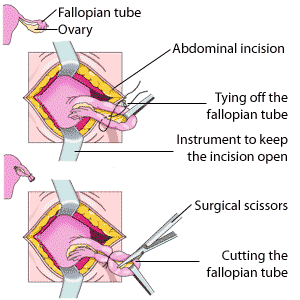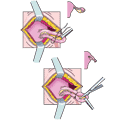Description of the procedure
Tubal ligation is the technical term for what is often called "getting your tubes tied." It is a common surgical procedure.
Every month the fallopian tubes carry an egg from one of your ovaries to the uterus. By blocking the fallopian tubes, the egg cannot travel to the uterus and be fertilized. If the egg isn't fertilized, pregnancy cannot occur.
Tubal ligation is a permanent method of birth control for women and requires serious consideration before it is performed.
Reversing this procedure is possible, but is not always successful. You should carefully consider the advantages and disadvantages of the procedure. Talk to your doctor about alternative options if you are unsure if tubal ligation is right for you.
When should this procedure be performed?
Doctors perform tubal ligation once and the result is permanent.
Why is this procedure performed?
Women choose to have tubal ligation for many reasons. It is an effective form of birth control if a woman and her partner have decided to have no more children or if they do not want any children.
Other reasons to have this procedure may include wanting to avoid passing on a genetic condition, or having condition that could be worsened by becoming pregnant. Some women choose it because their partner does not want to be sterilized.
Are there any risks and precautions?
Certain risks are common to all surgery and anesthesia. These risks depend on many factors including the type of surgery and your own medical condition. The possible, but very rare, side effects include: side effects of the anesthetic, breathing problems, infection, bleeding, scarring, and death. Tell your doctor if you are allergic to anesthesia.
Although a tubal ligation is generally considered safe, it does have some risk of side effects or complications. These include:
- damage to nearby organs (such as the bowel, bladder, or major blood vessels)
- pain in your lower abdomen
Certain health conditions or behaviours may increase your risk of complications after this surgery. These include diabetes, heart conditions, smoking, and excess weight.
Tubal ligations do not protect you from sexually transmitted infections (STIs) such as HIV/AIDS, chlamydia, and genital herpes. Safe sex practices (such as wearing condoms) are still your best protection against STIs.
There is a very low risk of ectopic pregnancy, when a fertilized egg implants outside the uterus (usually in the fallopian tubes), after a tubal ligation.
If you are concerned about any symptoms following this procedure, speak to your doctor. Take the time to be sure you understand all the risks of complications and side effects as well as any precautions you or your doctor can take to avoid them. Be sure your doctor understands all your concerns.
What happens during the procedure?
The tubal ligation procedure is usually performed in a hospital or surgical clinic with general anesthesia, so you won't be awake during the procedure. The surgeon will make one or two incisions in the abdomen, usually near the navel. Sometimes, carbon dioxide gas is pumped in to inflate the abdomen so the surgeon has better access to the fallopian tubes. A laparoscope, a long thin tube with a small camera and light on the end, is inserted for the doctor to better see internal organs. In some cases, the laparoscope is not used and the surgeon will make a larger incision in the area just above your pubic hair.
Doctors use various techniques to block the tubes. After the tubes are cut, they can be sealed with bands or clips, they can be stitched closed, or the doctor can use an electrical device to burn or cauterize the tubes (also known as electrocoagulation). All incisions are then closed using stitches.
The procedure generally takes about 30 minutes. In some cases, this procedure is done immediately after a woman gives birth.
How should I prepare for this procedure?
Before having this procedure, discuss the advantages, disadvantages, long-term risks and consequences associated with the procedure with your doctor. Be sure you fully understand what will happen and are comfortable with your doctor's answers to your questions.
Do not eat or drink anything after midnight the night before your surgery. . If your doctor has recommended different times, follow the timing recommended by your doctor.
You will need a pregnancy test before the procedure to make sure you are not pregnant.
Tell your doctor or prescriber about all prescription, over-the-counter (non-prescription), and herbal medications that you are taking. Also tell them about any medication allergies and medical conditions that you may have. Arrange for someone to drive you home from the hospital.
Ask your doctor or pharmacist whether you need to stop taking any of your medications before the procedure.
What can I expect after the procedure?
Most women are able to go home the same day that they have the procedure. The procedure does not usually prolong your hospital stay if you have it immediately after giving birth.
You may feel some abdominal discomfort or pain after the procedure. This is normal. Your doctor may recommend pain medications to help with any discomfort or pain. Pain in the shoulder area due to the carbon dioxide gas is also common and should go away in the hours after the procedure.
Before you go home, the doctor or nurse will go over what you need to do at home to complete your recovery.
Try to avoid any strenuous activities after the surgery. After at least one week, or when your body feels ready, normal activities (including sexual activity) can resume.
Severe abdominal pain, dizziness, fever, and symptoms of pregnancy require immediate attention. Watch your incision for signs of infection (e.g., bleeding or pus). Speak to your doctor as soon as possible if you notice these symptoms.
Again, keep in mind that tubal ligation does not protect against sexually transmitted infections.
Results
Tubal ligation is almost 100% effective at preventing pregnancy. Although pregnancy is still a possibility, it happens very rarely.
All material copyright MediResource Inc. 1996 – 2024. Terms and conditions of use. The contents herein are for informational purposes only. Always seek the advice of your physician or other qualified health provider with any questions you may have regarding a medical condition. Source: www.medbroadcast.com/procedure/getprocedure/Tubal-Ligation



